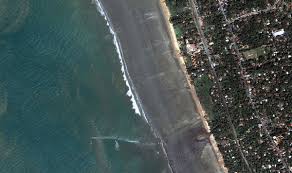
Military transports flew medical personnel, food, water and medicine to Samoa and American Samoa, both devastated by a tsunami triggered by an undersea earthquake. A cargo plane from New Zealand brought in a temporary morgue and a body identification team. Officials expect the death toll to rise as more areas are searched.
Survivors fled to higher ground on the islands after the magnitude 8.0 quake struck at 6:48 a.m. local time (1:48 p.m. EDT; 1748 GMT) Tuesday. The residents then were engulfed by four waves each 15 to 20 feet high that reached up to a mile inland.
four waves each 15 to 20 feet high that reached up to a mile inland.The Pacific Tsunami Warning Center in Hawaii said it issued an alert, but the waves got to the islands so quickly that residents only had about 10 minutes to respond. Another system designed to alert aid agencies suffered a hardware malfunction that delayed notification, but that did not affect island residents. The waves splintered houses and left cars and boats — many battered and upside down — scattered about the coastline. Debris as small as a spoon and as large as a piece of masonry weighing several tons were strewn in the mud.
(warning system animation)
The quake was centered about 120 miles south of the islands of Samoa, which has about 220,000 people, and American Samoa, a U.S. territory of 65,000. ( AP , 2008 )
What is a tsunami?
A tsunami (pronounced tsoo-NAH-mee) is a series of waves, made in an ocean or other body of water by an earthquake, landslide, volcanic eruption, or meteorite impact. Tsunamis can cause huge destruction when they hit coastlines. Some people call tsunamis “tidal waves”, but these large waves really have little to do with tides, so the term “tidal wave” does not really suit them.
Tsunami waves are different from the waves you can usually find rolling into the coast of a lake or ocean. Those waves are made by wind offshore and are quite small compared with tsunami waves. A tsunami wave in the open ocean can be more than 100 km across. That’s roughly the length of 1000 American football fields! Tsunami waves are huge and can travel very quickly, at about 700 km/hr, but they are only about one meter high in the open ocean.
As a tsunami wave travels into the shallower water near the coast, it slows and grows in height. Even though a tsunami may be barely visible at sea, it may grow to be many meters high near the coast and have a tremendous amount of energy. When it finally reaches the coast, a tsunami may appear as a rapidly rising or falling tide or a series of waves with a maximum height of up to 30 meters.
A few minutes before a tsunami wave hits, the water near shore may move away, exposing the ocean floor. Often the first wave may not be the largest, and additional waves may arrive at the coast every 10 to 60 minutes. They move much faster than a person can run. The danger from a tsunami can last for several hours after the arrival of the first wave. Unlike other waves, tsunami waves typically do not curl and break.
Coasts affected by a tsunami will be severely eroded. A tsunami can cause flooding hundreds of meters inland. The water moves with such force that it is capable of crushing homes and other buildings. ( Gardinier, Lisa. 2008Windows to the Universe, at http://www.windows.ucar.edu/)
On the morning of December 26, 2004, many coastal residents of northwestern Sumatra were startled as water at the shore dramatically receded below the normal low-water mark, leaving fish flapping on the exposed beach. The people drawn closer to the coast by this remarkable sight surely didn't know how to explain the water's bizarre behavior. Yet even in the early hours of the tsunami disaster, scientists began to grasp what was happening. In the following days, using maps of the seafloor and seismic data, tsunami researchers produced remarkably accurate computer simulations of the monstrous series of waves that took hundreds of thousands of lives.
Click here for an interactive view of the ANATOMY OF A TSUNAMI... the 2004 tsunami in the Indian Ocean. This is a good link to Enchanted Learning for a tsunami glossary.
Watch this video to learn about the amazing power unleashed into the ocean when the Ocean Floor breaks...
The comments box is open
What do you think?
How does this information help your understanding of the world around us?
What more would you like to know?


I feel bad for Sumatra. The tsunami destroyed peoples homes it not fair to them.
ReplyDeleteJuliane W Yellow class p.3
I completely understand how you feel. that's just one more reason for ocean education, so that more people can be better prepared for emergencies.
ReplyDeleteI did not know about tsunamis before i read this artical. It was very interesting.
ReplyDeleteJase P. P.2 orange
The one thing that scares me the most is that Florida is so low, we could totally sink if a tsunami occures! That is CRAZY!!! We just need to be thankful that it hasen't happened. I know someone who left Indonesia one day before the tsunami struck.
ReplyDeleteTaylor Boyd Blue
It's bad that people get their homes destroyed by natural causes like tsunamis when sometimes they don't even know it's coming.. I wonder what they did with their homes, if they put them on strong stilts, built them more away from the water, or built it wall.
ReplyDeleteJordan L. Orange
i agree it awful when people lose every thing they have when natural diasters such as tsunamis strikes.
ReplyDeleteAby P.2 (orange)
I saw this on the news. Its bad to think people are living like that and there is so little that we can do. There was just so far they could go in such a little time. I heard that there was these bells on beoys out in the ocean that sounds t give wornings what happened?
ReplyDeleteryan ( violet)
Ryan,
ReplyDeleteThey couldn't out run the wave. 500 miles an hour is the speed of a jet plane.
I think that video is intense and was very intertaining.But i also think that we can come up with better warnnings to save more peoples lives.The imformation helps me understand that tsunamis can really destroy the land and the world and everything else in its path.I would like to no more about more tsunamis they are interesting.
ReplyDeleteby Alex malia class color: yellow
I agree, intense a good descriptive word for this video.
ReplyDeleteHoly Cow!!! that is really big!! those waves are ferious and freakishly feroious!!I would be scared to death if that happened...but 500miles per hour is way to fast you would never be able to out run it!
ReplyDeleteMichelle M. Period 3 Yellow
i think thats not fair for the people they loose their houses,and family! why does the tsunami have to take their lifes away?
ReplyDeletefrom,Savannah:green
I still think the that Mr V is right on how much informatin is on this site. But lately he has been gone and its hard to remenber.
ReplyDeleteI don't understand how a wave can be going that fast.It's insane!!! I think people should try even harder and try to keep a closer eye on these kind of things!!I feel bad about how those people couldn't do a thing!!!I wonder what we(in FL and the US)can do for the people around the world dealing with these tragic events?
ReplyDeleteThere are many things we can do.. but most important is to learn and understand more about nature. People get very wrapped up in themselves and ignore the fact that we are very small and unimportant when it comes to the Earth. Whenever people ignore that fact, it comes back to haunt them. Study, learn more, remember what you learn, use it for the best things.
ReplyDelete